COIT 20248: Information Systems Analysis and Design Report - Hospital
VerifiedAdded on 2023/01/23
|13
|3177
|86
Report
AI Summary
This report presents a comprehensive analysis of a proposed hospital information system. It begins with an introduction outlining the project's objectives, which include improving patient record management and enhancing business efficiency. The report then details the chosen system development approach, the waterfall model, and discusses its advantages and disadvantages in this context. A significant portion of the report is dedicated to outlining the system's functional and non-functional requirements, covering aspects such as patient registration, report generation, security, and performance. The report also includes a project cost-benefit analysis, using financial metrics like ROI and NPV to assess the project's viability. A project schedule, presented via a work breakdown structure and Gantt chart, is also included. Finally, the report explores system information requirement investigation techniques such as interviews, questionnaires, and observations, identifying key stakeholders and evaluating the usefulness of each technique.
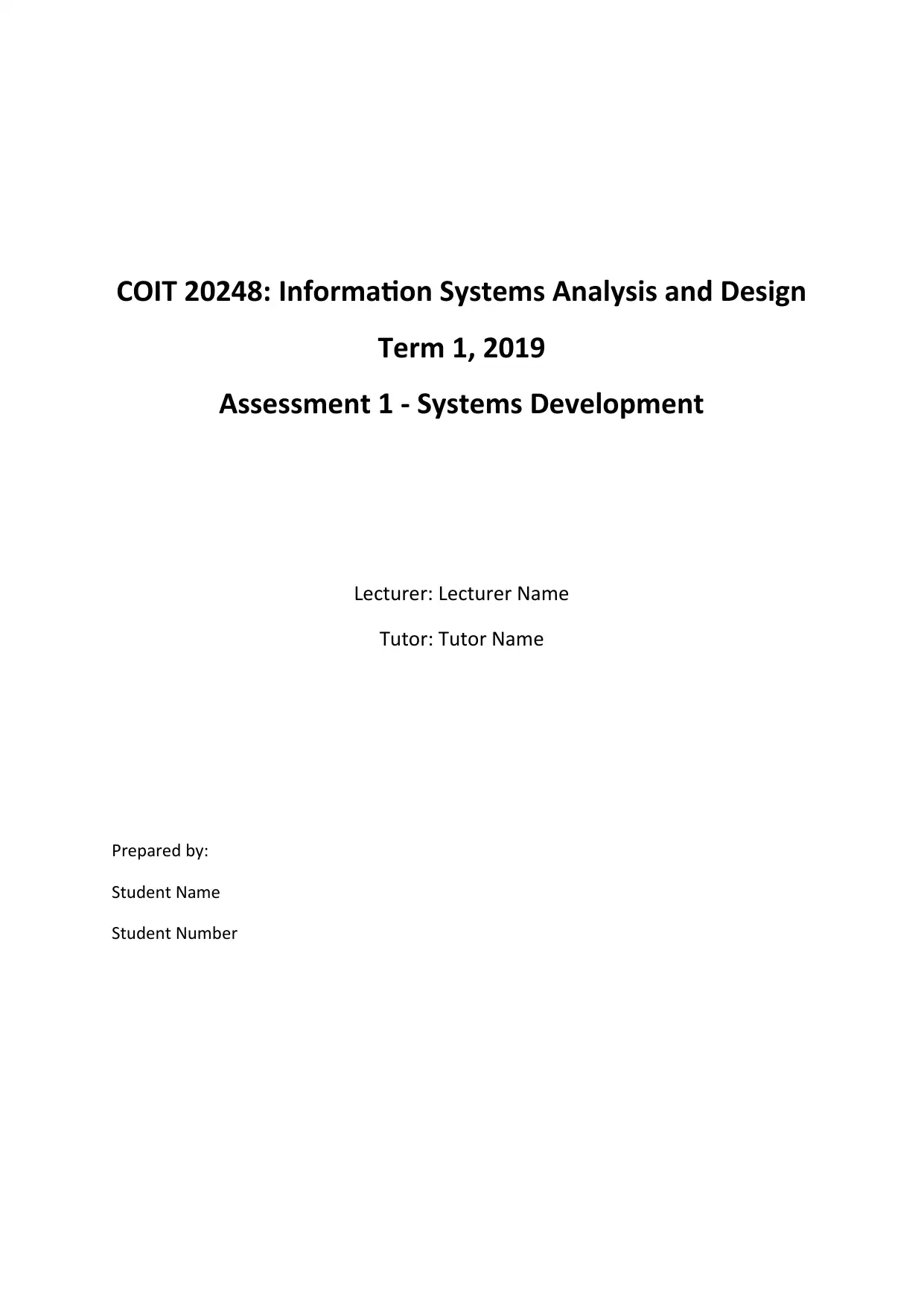
COIT 20248: Information Systems Analysis and Design
Term 1, 2019
Assessment 1 - Systems Development
Lecturer: Lecturer Name
Tutor: Tutor Name
Prepared by:
Student Name
Student Number
Term 1, 2019
Assessment 1 - Systems Development
Lecturer: Lecturer Name
Tutor: Tutor Name
Prepared by:
Student Name
Student Number
Paraphrase This Document
Need a fresh take? Get an instant paraphrase of this document with our AI Paraphraser
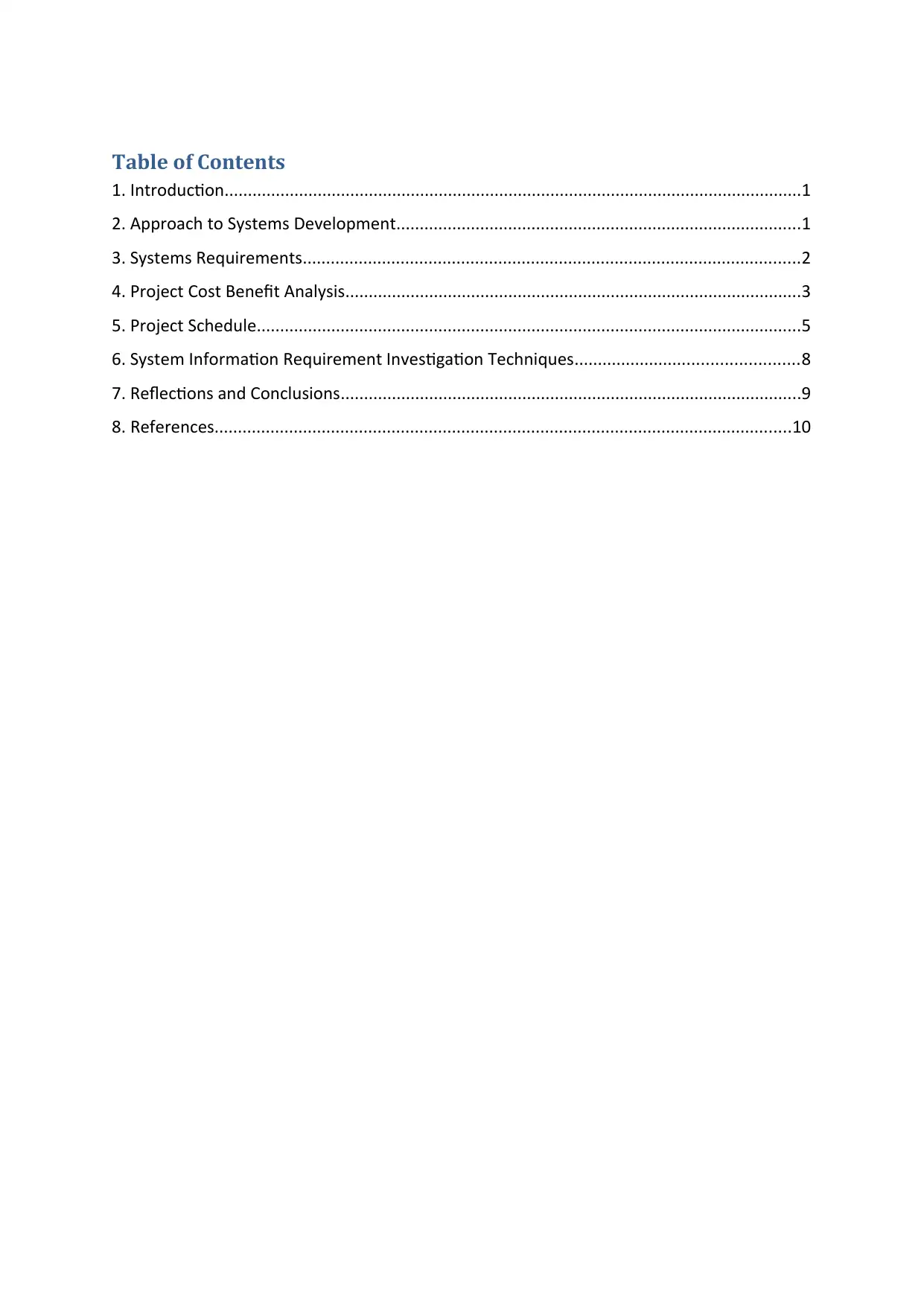
Table of Contents
1. Introduction............................................................................................................................1
2. Approach to Systems Development.......................................................................................1
3. Systems Requirements...........................................................................................................2
4. Project Cost Benefit Analysis..................................................................................................3
5. Project Schedule.....................................................................................................................5
6. System Information Requirement Investigation Techniques................................................8
7. Reflections and Conclusions...................................................................................................9
8. References............................................................................................................................10
1. Introduction............................................................................................................................1
2. Approach to Systems Development.......................................................................................1
3. Systems Requirements...........................................................................................................2
4. Project Cost Benefit Analysis..................................................................................................3
5. Project Schedule.....................................................................................................................5
6. System Information Requirement Investigation Techniques................................................8
7. Reflections and Conclusions...................................................................................................9
8. References............................................................................................................................10
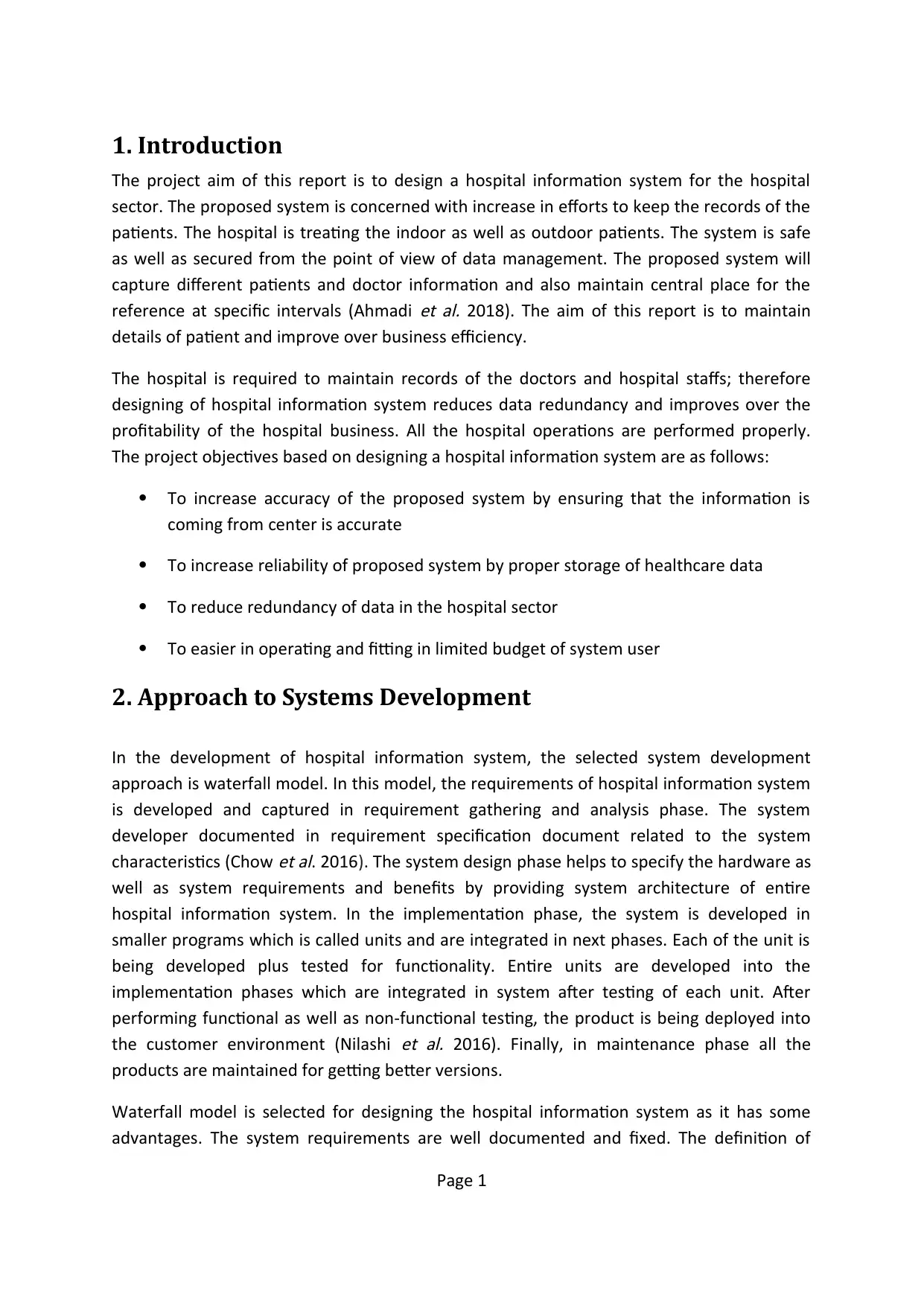
1. Introduction
The project aim of this report is to design a hospital information system for the hospital
sector. The proposed system is concerned with increase in efforts to keep the records of the
patients. The hospital is treating the indoor as well as outdoor patients. The system is safe
as well as secured from the point of view of data management. The proposed system will
capture different patients and doctor information and also maintain central place for the
reference at specific intervals (Ahmadi
et al. 2018). The aim of this report is to maintain
details of patient and improve over business efficiency.
The hospital is required to maintain records of the doctors and hospital staffs; therefore
designing of hospital information system reduces data redundancy and improves over the
profitability of the hospital business. All the hospital operations are performed properly.
The project objectives based on designing a hospital information system are as follows:
To increase accuracy of the proposed system by ensuring that the information is
coming from center is accurate
To increase reliability of proposed system by proper storage of healthcare data
To reduce redundancy of data in the hospital sector
To easier in operating and fitting in limited budget of system user
2. Approach to Systems Development
In the development of hospital information system, the selected system development
approach is waterfall model. In this model, the requirements of hospital information system
is developed and captured in requirement gathering and analysis phase. The system
developer documented in requirement specification document related to the system
characteristics (Chow
et al. 2016). The system design phase helps to specify the hardware as
well as system requirements and benefits by providing system architecture of entire
hospital information system. In the implementation phase, the system is developed in
smaller programs which is called units and are integrated in next phases. Each of the unit is
being developed plus tested for functionality. Entire units are developed into the
implementation phases which are integrated in system after testing of each unit. After
performing functional as well as non-functional testing, the product is being deployed into
the customer environment (Nilashi
et al. 2016). Finally, in maintenance phase all the
products are maintained for getting better versions.
Waterfall model is selected for designing the hospital information system as it has some
advantages. The system requirements are well documented and fixed. The definition of
Page 1
The project aim of this report is to design a hospital information system for the hospital
sector. The proposed system is concerned with increase in efforts to keep the records of the
patients. The hospital is treating the indoor as well as outdoor patients. The system is safe
as well as secured from the point of view of data management. The proposed system will
capture different patients and doctor information and also maintain central place for the
reference at specific intervals (Ahmadi
et al. 2018). The aim of this report is to maintain
details of patient and improve over business efficiency.
The hospital is required to maintain records of the doctors and hospital staffs; therefore
designing of hospital information system reduces data redundancy and improves over the
profitability of the hospital business. All the hospital operations are performed properly.
The project objectives based on designing a hospital information system are as follows:
To increase accuracy of the proposed system by ensuring that the information is
coming from center is accurate
To increase reliability of proposed system by proper storage of healthcare data
To reduce redundancy of data in the hospital sector
To easier in operating and fitting in limited budget of system user
2. Approach to Systems Development
In the development of hospital information system, the selected system development
approach is waterfall model. In this model, the requirements of hospital information system
is developed and captured in requirement gathering and analysis phase. The system
developer documented in requirement specification document related to the system
characteristics (Chow
et al. 2016). The system design phase helps to specify the hardware as
well as system requirements and benefits by providing system architecture of entire
hospital information system. In the implementation phase, the system is developed in
smaller programs which is called units and are integrated in next phases. Each of the unit is
being developed plus tested for functionality. Entire units are developed into the
implementation phases which are integrated in system after testing of each unit. After
performing functional as well as non-functional testing, the product is being deployed into
the customer environment (Nilashi
et al. 2016). Finally, in maintenance phase all the
products are maintained for getting better versions.
Waterfall model is selected for designing the hospital information system as it has some
advantages. The system requirements are well documented and fixed. The definition of
Page 1
⊘ This is a preview!⊘
Do you want full access?
Subscribe today to unlock all pages.

Trusted by 1+ million students worldwide
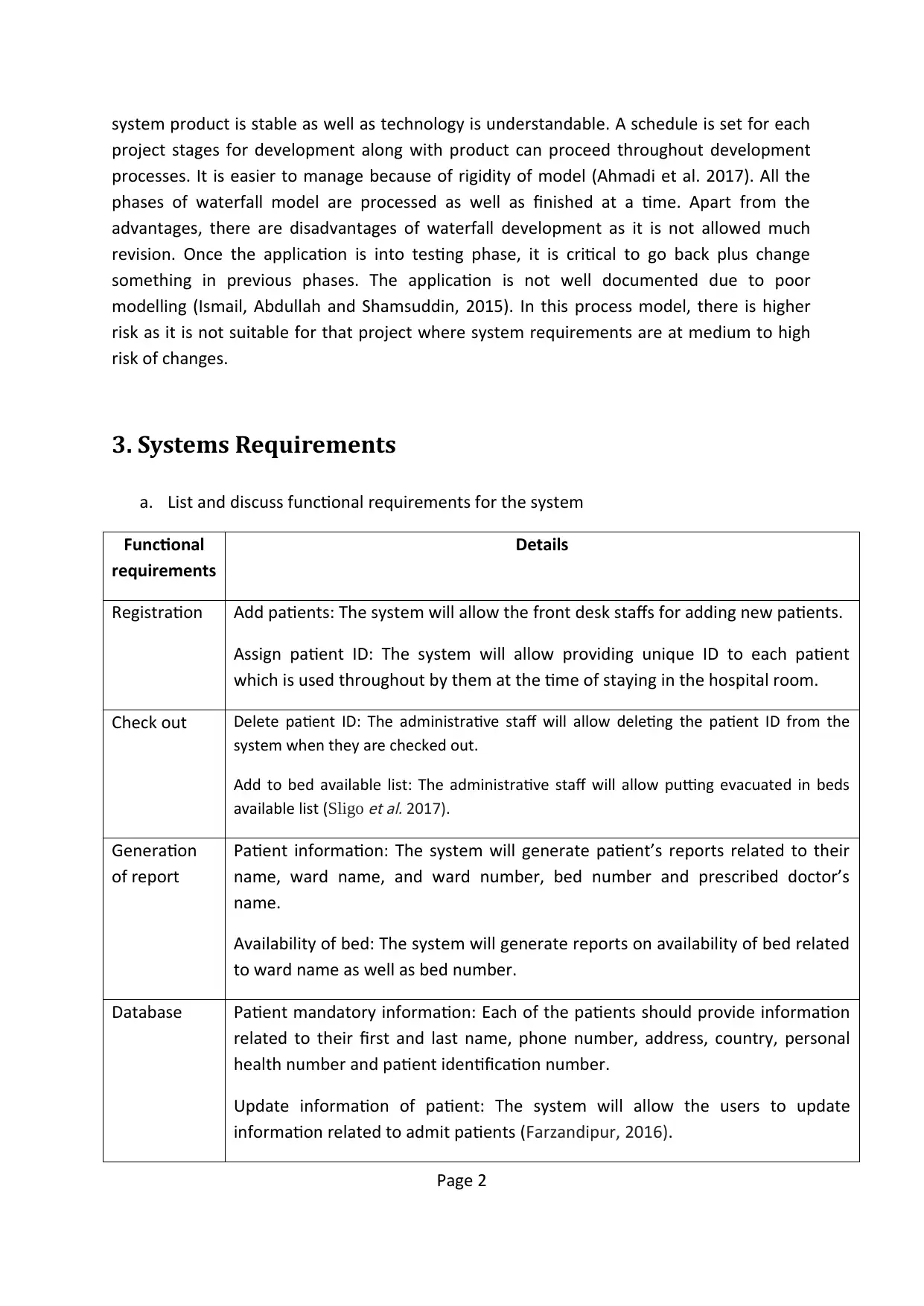
system product is stable as well as technology is understandable. A schedule is set for each
project stages for development along with product can proceed throughout development
processes. It is easier to manage because of rigidity of model (Ahmadi et al. 2017). All the
phases of waterfall model are processed as well as finished at a time. Apart from the
advantages, there are disadvantages of waterfall development as it is not allowed much
revision. Once the application is into testing phase, it is critical to go back plus change
something in previous phases. The application is not well documented due to poor
modelling (Ismail, Abdullah and Shamsuddin, 2015). In this process model, there is higher
risk as it is not suitable for that project where system requirements are at medium to high
risk of changes.
3. Systems Requirements
a. List and discuss functional requirements for the system
Functional
requirements
Details
Registration Add patients: The system will allow the front desk staffs for adding new patients.
Assign patient ID: The system will allow providing unique ID to each patient
which is used throughout by them at the time of staying in the hospital room.
Check out Delete patient ID: The administrative staff will allow deleting the patient ID from the
system when they are checked out.
Add to bed available list: The administrative staff will allow putting evacuated in beds
available list (Sligo
et al. 2017).
Generation
of report
Patient information: The system will generate patient’s reports related to their
name, ward name, and ward number, bed number and prescribed doctor’s
name.
Availability of bed: The system will generate reports on availability of bed related
to ward name as well as bed number.
Database Patient mandatory information: Each of the patients should provide information
related to their first and last name, phone number, address, country, personal
health number and patient identification number.
Update information of patient: The system will allow the users to update
information related to admit patients (Farzandipur, 2016).
Page 2
project stages for development along with product can proceed throughout development
processes. It is easier to manage because of rigidity of model (Ahmadi et al. 2017). All the
phases of waterfall model are processed as well as finished at a time. Apart from the
advantages, there are disadvantages of waterfall development as it is not allowed much
revision. Once the application is into testing phase, it is critical to go back plus change
something in previous phases. The application is not well documented due to poor
modelling (Ismail, Abdullah and Shamsuddin, 2015). In this process model, there is higher
risk as it is not suitable for that project where system requirements are at medium to high
risk of changes.
3. Systems Requirements
a. List and discuss functional requirements for the system
Functional
requirements
Details
Registration Add patients: The system will allow the front desk staffs for adding new patients.
Assign patient ID: The system will allow providing unique ID to each patient
which is used throughout by them at the time of staying in the hospital room.
Check out Delete patient ID: The administrative staff will allow deleting the patient ID from the
system when they are checked out.
Add to bed available list: The administrative staff will allow putting evacuated in beds
available list (Sligo
et al. 2017).
Generation
of report
Patient information: The system will generate patient’s reports related to their
name, ward name, and ward number, bed number and prescribed doctor’s
name.
Availability of bed: The system will generate reports on availability of bed related
to ward name as well as bed number.
Database Patient mandatory information: Each of the patients should provide information
related to their first and last name, phone number, address, country, personal
health number and patient identification number.
Update information of patient: The system will allow the users to update
information related to admit patients (Farzandipur, 2016).
Page 2
Paraphrase This Document
Need a fresh take? Get an instant paraphrase of this document with our AI Paraphraser
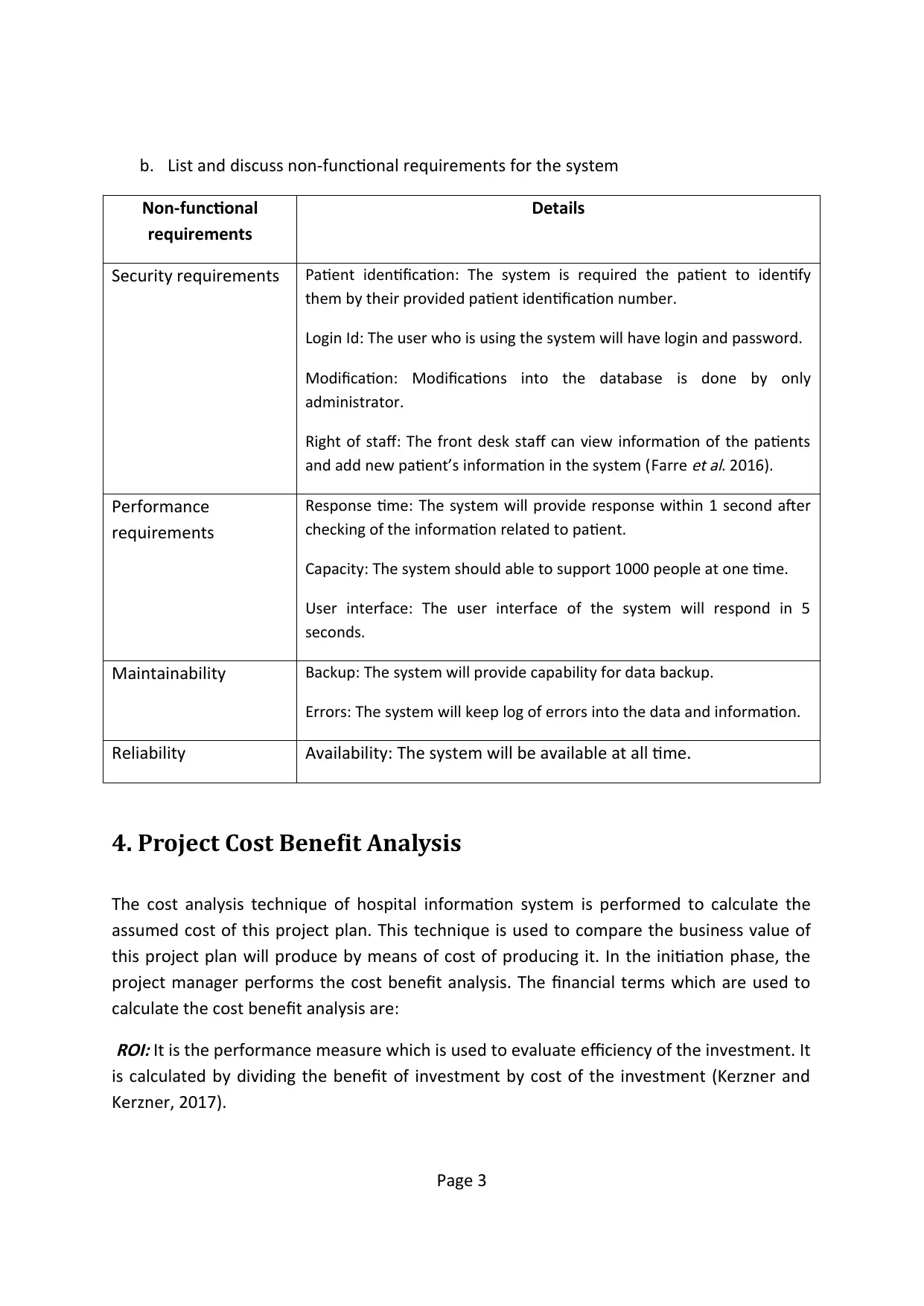
b. List and discuss non-functional requirements for the system
Non-functional
requirements
Details
Security requirements Patient identification: The system is required the patient to identify
them by their provided patient identification number.
Login Id: The user who is using the system will have login and password.
Modification: Modifications into the database is done by only
administrator.
Right of staff: The front desk staff can view information of the patients
and add new patient’s information in the system (Farre
et al. 2016).
Performance
requirements
Response time: The system will provide response within 1 second after
checking of the information related to patient.
Capacity: The system should able to support 1000 people at one time.
User interface: The user interface of the system will respond in 5
seconds.
Maintainability Backup: The system will provide capability for data backup.
Errors: The system will keep log of errors into the data and information.
Reliability Availability: The system will be available at all time.
4. Project Cost Benefit Analysis
The cost analysis technique of hospital information system is performed to calculate the
assumed cost of this project plan. This technique is used to compare the business value of
this project plan will produce by means of cost of producing it. In the initiation phase, the
project manager performs the cost benefit analysis. The financial terms which are used to
calculate the cost benefit analysis are:
ROI: It is the performance measure which is used to evaluate efficiency of the investment. It
is calculated by dividing the benefit of investment by cost of the investment (Kerzner and
Kerzner, 2017).
Page 3
Non-functional
requirements
Details
Security requirements Patient identification: The system is required the patient to identify
them by their provided patient identification number.
Login Id: The user who is using the system will have login and password.
Modification: Modifications into the database is done by only
administrator.
Right of staff: The front desk staff can view information of the patients
and add new patient’s information in the system (Farre
et al. 2016).
Performance
requirements
Response time: The system will provide response within 1 second after
checking of the information related to patient.
Capacity: The system should able to support 1000 people at one time.
User interface: The user interface of the system will respond in 5
seconds.
Maintainability Backup: The system will provide capability for data backup.
Errors: The system will keep log of errors into the data and information.
Reliability Availability: The system will be available at all time.
4. Project Cost Benefit Analysis
The cost analysis technique of hospital information system is performed to calculate the
assumed cost of this project plan. This technique is used to compare the business value of
this project plan will produce by means of cost of producing it. In the initiation phase, the
project manager performs the cost benefit analysis. The financial terms which are used to
calculate the cost benefit analysis are:
ROI: It is the performance measure which is used to evaluate efficiency of the investment. It
is calculated by dividing the benefit of investment by cost of the investment (Kerzner and
Kerzner, 2017).
Page 3
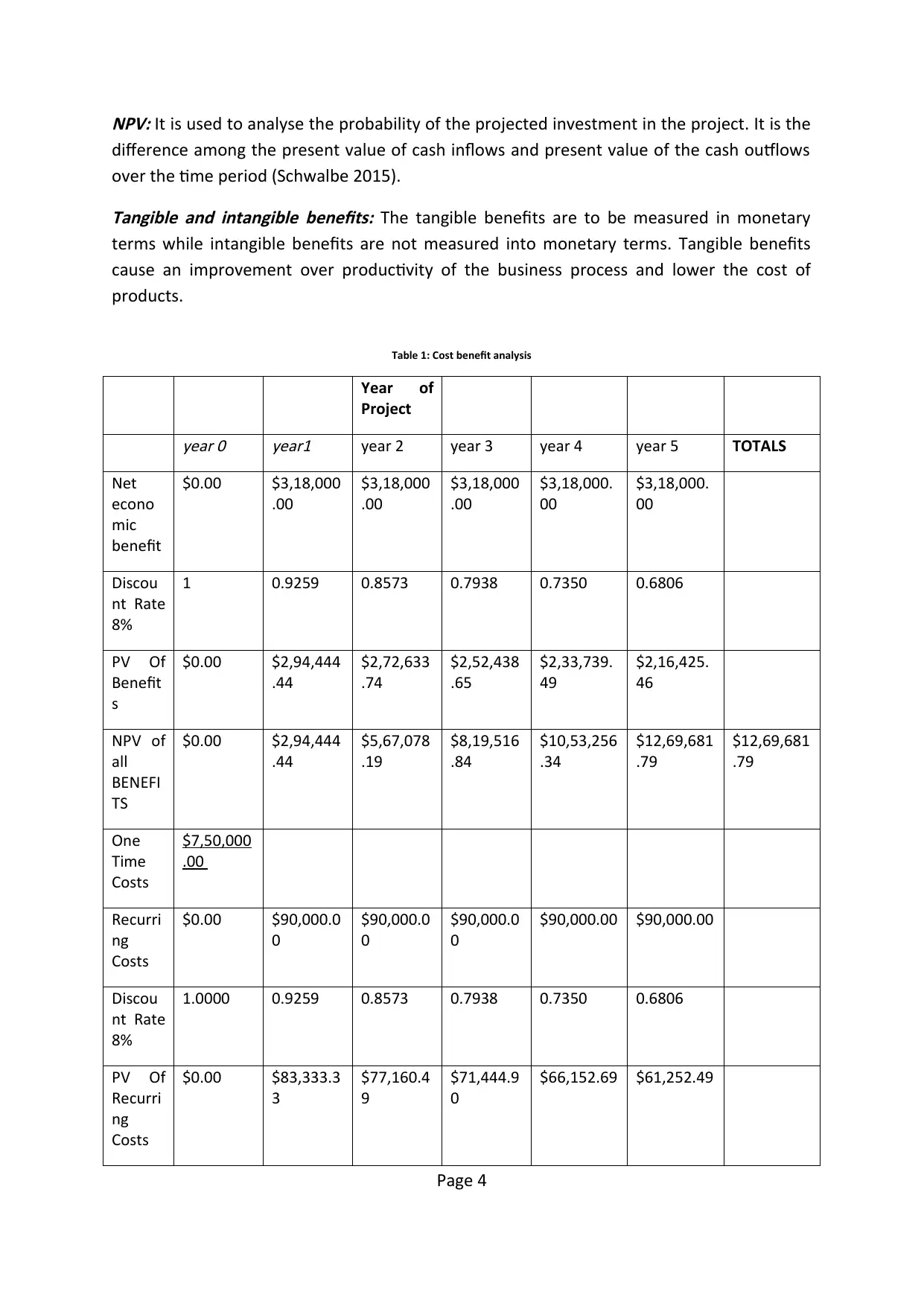
NPV: It is used to analyse the probability of the projected investment in the project. It is the
difference among the present value of cash inflows and present value of the cash outflows
over the time period (Schwalbe 2015).
Tangible and intangible benefits: The tangible benefits are to be measured in monetary
terms while intangible benefits are not measured into monetary terms. Tangible benefits
cause an improvement over productivity of the business process and lower the cost of
products.
Table 1: Cost benefit analysis
Year of
Project
year 0 year1 year 2 year 3 year 4 year 5 TOTALS
Net
econo
mic
benefit
$0.00 $3,18,000
.00
$3,18,000
.00
$3,18,000
.00
$3,18,000.
00
$3,18,000.
00
Discou
nt Rate
8%
1 0.9259 0.8573 0.7938 0.7350 0.6806
PV Of
Benefit
s
$0.00 $2,94,444
.44
$2,72,633
.74
$2,52,438
.65
$2,33,739.
49
$2,16,425.
46
NPV of
all
BENEFI
TS
$0.00 $2,94,444
.44
$5,67,078
.19
$8,19,516
.84
$10,53,256
.34
$12,69,681
.79
$12,69,681
.79
One
Time
Costs
$7,50,000
.00
Recurri
ng
Costs
$0.00 $90,000.0
0
$90,000.0
0
$90,000.0
0
$90,000.00 $90,000.00
Discou
nt Rate
8%
1.0000 0.9259 0.8573 0.7938 0.7350 0.6806
PV Of
Recurri
ng
Costs
$0.00 $83,333.3
3
$77,160.4
9
$71,444.9
0
$66,152.69 $61,252.49
Page 4
difference among the present value of cash inflows and present value of the cash outflows
over the time period (Schwalbe 2015).
Tangible and intangible benefits: The tangible benefits are to be measured in monetary
terms while intangible benefits are not measured into monetary terms. Tangible benefits
cause an improvement over productivity of the business process and lower the cost of
products.
Table 1: Cost benefit analysis
Year of
Project
year 0 year1 year 2 year 3 year 4 year 5 TOTALS
Net
econo
mic
benefit
$0.00 $3,18,000
.00
$3,18,000
.00
$3,18,000
.00
$3,18,000.
00
$3,18,000.
00
Discou
nt Rate
8%
1 0.9259 0.8573 0.7938 0.7350 0.6806
PV Of
Benefit
s
$0.00 $2,94,444
.44
$2,72,633
.74
$2,52,438
.65
$2,33,739.
49
$2,16,425.
46
NPV of
all
BENEFI
TS
$0.00 $2,94,444
.44
$5,67,078
.19
$8,19,516
.84
$10,53,256
.34
$12,69,681
.79
$12,69,681
.79
One
Time
Costs
$7,50,000
.00
Recurri
ng
Costs
$0.00 $90,000.0
0
$90,000.0
0
$90,000.0
0
$90,000.00 $90,000.00
Discou
nt Rate
8%
1.0000 0.9259 0.8573 0.7938 0.7350 0.6806
PV Of
Recurri
ng
Costs
$0.00 $83,333.3
3
$77,160.4
9
$71,444.9
0
$66,152.69 $61,252.49
Page 4
⊘ This is a preview!⊘
Do you want full access?
Subscribe today to unlock all pages.

Trusted by 1+ million students worldwide
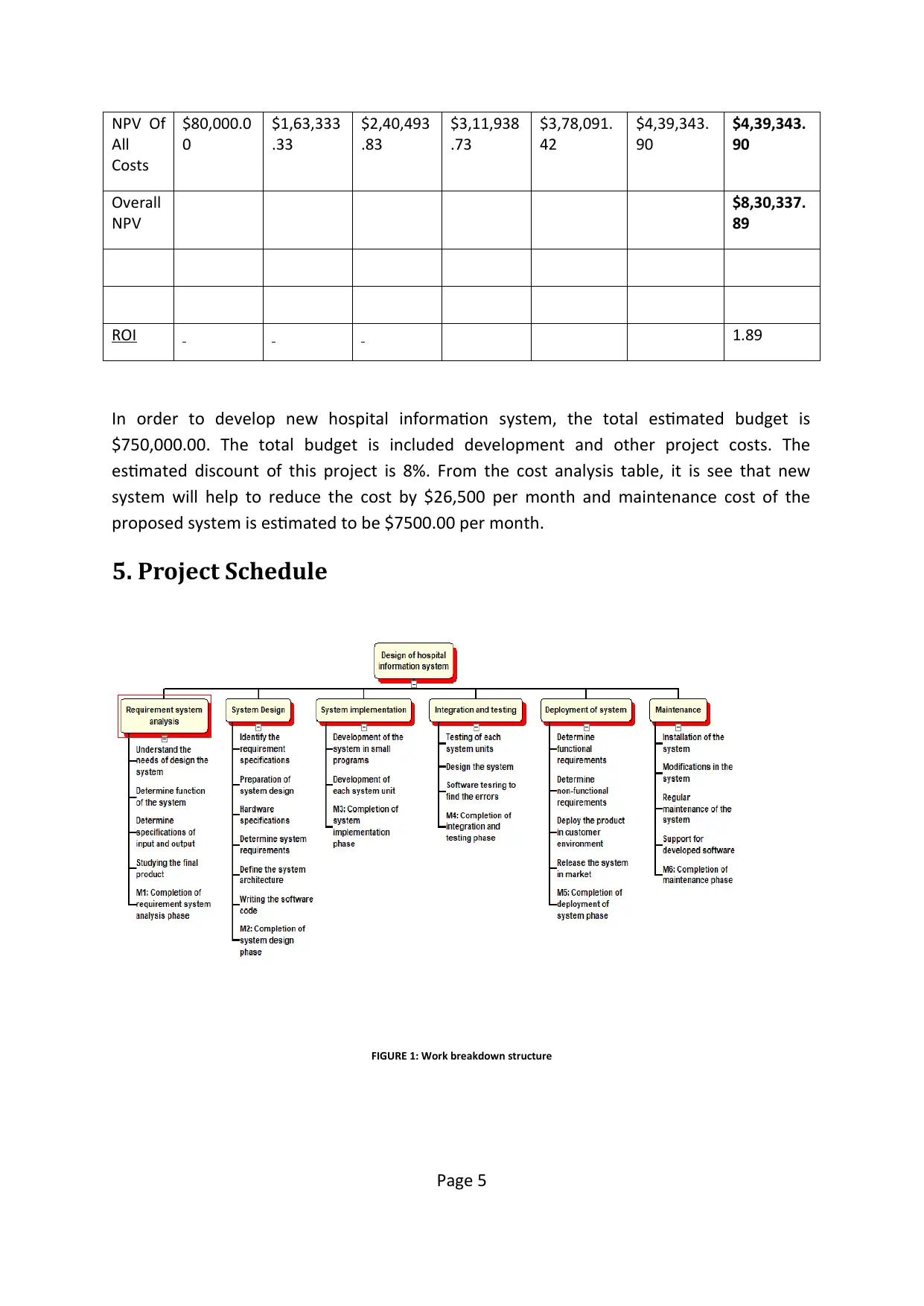
NPV Of
All
Costs
$80,000.0
0
$1,63,333
.33
$2,40,493
.83
$3,11,938
.73
$3,78,091.
42
$4,39,343.
90
$4,39,343.
90
Overall
NPV
$8,30,337.
89
ROI 1.89
In order to develop new hospital information system, the total estimated budget is
$750,000.00. The total budget is included development and other project costs. The
estimated discount of this project is 8%. From the cost analysis table, it is see that new
system will help to reduce the cost by $26,500 per month and maintenance cost of the
proposed system is estimated to be $7500.00 per month.
5. Project Schedule
FIGURE 1: Work breakdown structure
Page 5
All
Costs
$80,000.0
0
$1,63,333
.33
$2,40,493
.83
$3,11,938
.73
$3,78,091.
42
$4,39,343.
90
$4,39,343.
90
Overall
NPV
$8,30,337.
89
ROI 1.89
In order to develop new hospital information system, the total estimated budget is
$750,000.00. The total budget is included development and other project costs. The
estimated discount of this project is 8%. From the cost analysis table, it is see that new
system will help to reduce the cost by $26,500 per month and maintenance cost of the
proposed system is estimated to be $7500.00 per month.
5. Project Schedule
FIGURE 1: Work breakdown structure
Page 5
Paraphrase This Document
Need a fresh take? Get an instant paraphrase of this document with our AI Paraphraser

FIGURE 2: Gantt chart
Page 6
Page 6
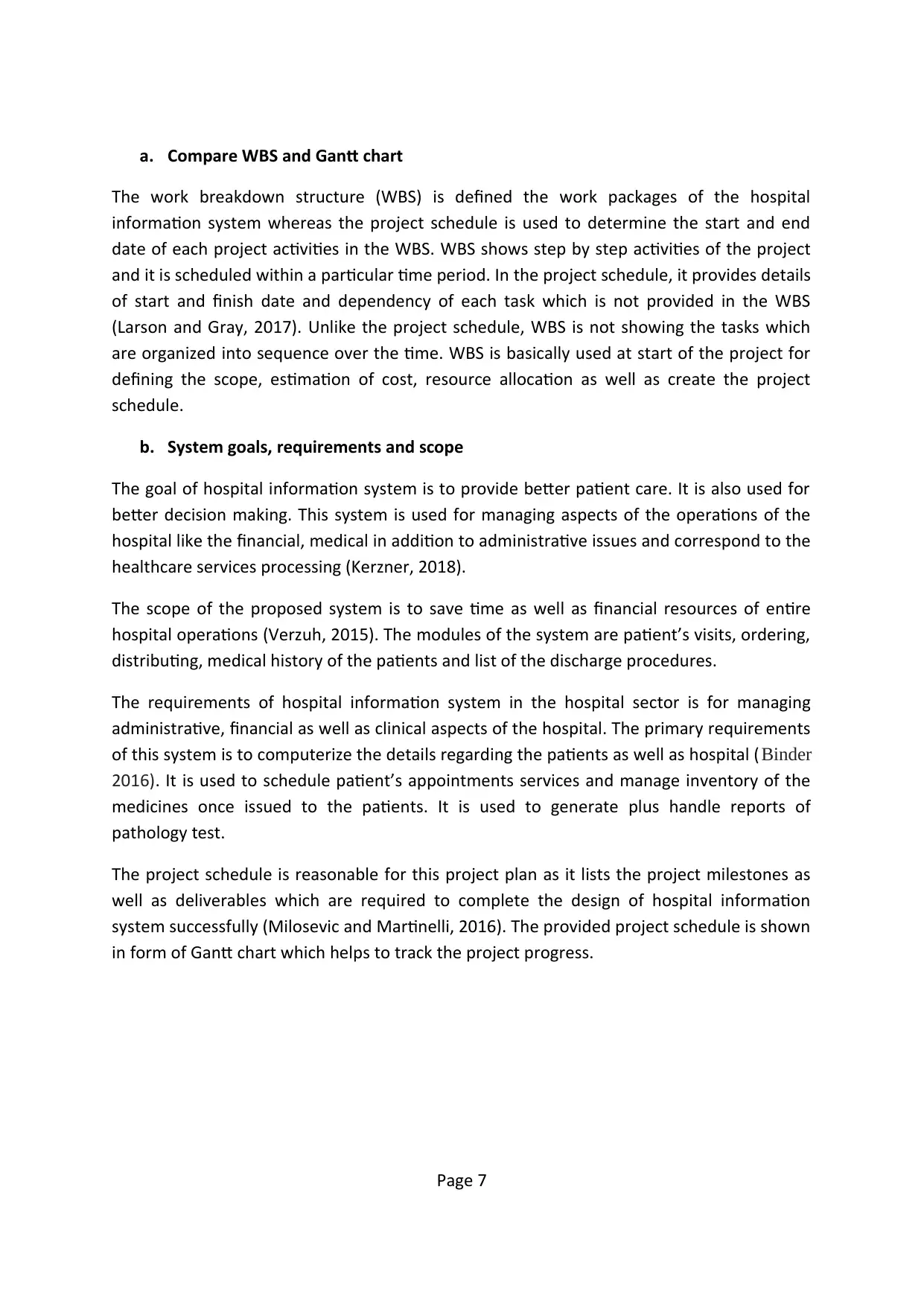
a. Compare WBS and Gantt chart
The work breakdown structure (WBS) is defined the work packages of the hospital
information system whereas the project schedule is used to determine the start and end
date of each project activities in the WBS. WBS shows step by step activities of the project
and it is scheduled within a particular time period. In the project schedule, it provides details
of start and finish date and dependency of each task which is not provided in the WBS
(Larson and Gray, 2017). Unlike the project schedule, WBS is not showing the tasks which
are organized into sequence over the time. WBS is basically used at start of the project for
defining the scope, estimation of cost, resource allocation as well as create the project
schedule.
b. System goals, requirements and scope
The goal of hospital information system is to provide better patient care. It is also used for
better decision making. This system is used for managing aspects of the operations of the
hospital like the financial, medical in addition to administrative issues and correspond to the
healthcare services processing (Kerzner, 2018).
The scope of the proposed system is to save time as well as financial resources of entire
hospital operations (Verzuh, 2015). The modules of the system are patient’s visits, ordering,
distributing, medical history of the patients and list of the discharge procedures.
The requirements of hospital information system in the hospital sector is for managing
administrative, financial as well as clinical aspects of the hospital. The primary requirements
of this system is to computerize the details regarding the patients as well as hospital (Binder
2016). It is used to schedule patient’s appointments services and manage inventory of the
medicines once issued to the patients. It is used to generate plus handle reports of
pathology test.
The project schedule is reasonable for this project plan as it lists the project milestones as
well as deliverables which are required to complete the design of hospital information
system successfully (Milosevic and Martinelli, 2016). The provided project schedule is shown
in form of Gantt chart which helps to track the project progress.
Page 7
The work breakdown structure (WBS) is defined the work packages of the hospital
information system whereas the project schedule is used to determine the start and end
date of each project activities in the WBS. WBS shows step by step activities of the project
and it is scheduled within a particular time period. In the project schedule, it provides details
of start and finish date and dependency of each task which is not provided in the WBS
(Larson and Gray, 2017). Unlike the project schedule, WBS is not showing the tasks which
are organized into sequence over the time. WBS is basically used at start of the project for
defining the scope, estimation of cost, resource allocation as well as create the project
schedule.
b. System goals, requirements and scope
The goal of hospital information system is to provide better patient care. It is also used for
better decision making. This system is used for managing aspects of the operations of the
hospital like the financial, medical in addition to administrative issues and correspond to the
healthcare services processing (Kerzner, 2018).
The scope of the proposed system is to save time as well as financial resources of entire
hospital operations (Verzuh, 2015). The modules of the system are patient’s visits, ordering,
distributing, medical history of the patients and list of the discharge procedures.
The requirements of hospital information system in the hospital sector is for managing
administrative, financial as well as clinical aspects of the hospital. The primary requirements
of this system is to computerize the details regarding the patients as well as hospital (Binder
2016). It is used to schedule patient’s appointments services and manage inventory of the
medicines once issued to the patients. It is used to generate plus handle reports of
pathology test.
The project schedule is reasonable for this project plan as it lists the project milestones as
well as deliverables which are required to complete the design of hospital information
system successfully (Milosevic and Martinelli, 2016). The provided project schedule is shown
in form of Gantt chart which helps to track the project progress.
Page 7
⊘ This is a preview!⊘
Do you want full access?
Subscribe today to unlock all pages.

Trusted by 1+ million students worldwide
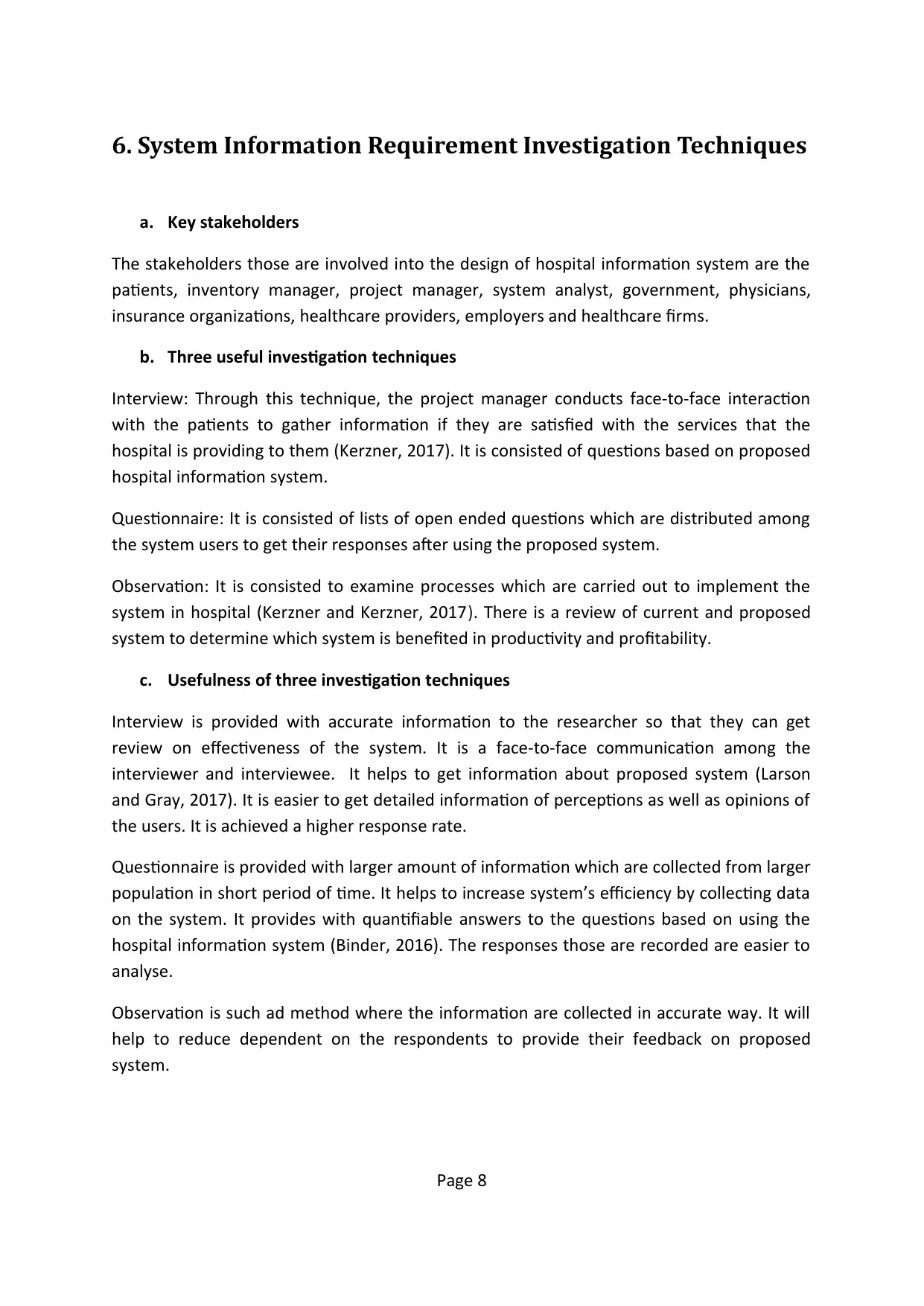
6. System Information Requirement Investigation Techniques
a. Key stakeholders
The stakeholders those are involved into the design of hospital information system are the
patients, inventory manager, project manager, system analyst, government, physicians,
insurance organizations, healthcare providers, employers and healthcare firms.
b. Three useful investigation techniques
Interview: Through this technique, the project manager conducts face-to-face interaction
with the patients to gather information if they are satisfied with the services that the
hospital is providing to them (Kerzner, 2017). It is consisted of questions based on proposed
hospital information system.
Questionnaire: It is consisted of lists of open ended questions which are distributed among
the system users to get their responses after using the proposed system.
Observation: It is consisted to examine processes which are carried out to implement the
system in hospital (Kerzner and Kerzner, 2017). There is a review of current and proposed
system to determine which system is benefited in productivity and profitability.
c. Usefulness of three investigation techniques
Interview is provided with accurate information to the researcher so that they can get
review on effectiveness of the system. It is a face-to-face communication among the
interviewer and interviewee. It helps to get information about proposed system (Larson
and Gray, 2017). It is easier to get detailed information of perceptions as well as opinions of
the users. It is achieved a higher response rate.
Questionnaire is provided with larger amount of information which are collected from larger
population in short period of time. It helps to increase system’s efficiency by collecting data
on the system. It provides with quantifiable answers to the questions based on using the
hospital information system (Binder, 2016). The responses those are recorded are easier to
analyse.
Observation is such ad method where the information are collected in accurate way. It will
help to reduce dependent on the respondents to provide their feedback on proposed
system.
Page 8
a. Key stakeholders
The stakeholders those are involved into the design of hospital information system are the
patients, inventory manager, project manager, system analyst, government, physicians,
insurance organizations, healthcare providers, employers and healthcare firms.
b. Three useful investigation techniques
Interview: Through this technique, the project manager conducts face-to-face interaction
with the patients to gather information if they are satisfied with the services that the
hospital is providing to them (Kerzner, 2017). It is consisted of questions based on proposed
hospital information system.
Questionnaire: It is consisted of lists of open ended questions which are distributed among
the system users to get their responses after using the proposed system.
Observation: It is consisted to examine processes which are carried out to implement the
system in hospital (Kerzner and Kerzner, 2017). There is a review of current and proposed
system to determine which system is benefited in productivity and profitability.
c. Usefulness of three investigation techniques
Interview is provided with accurate information to the researcher so that they can get
review on effectiveness of the system. It is a face-to-face communication among the
interviewer and interviewee. It helps to get information about proposed system (Larson
and Gray, 2017). It is easier to get detailed information of perceptions as well as opinions of
the users. It is achieved a higher response rate.
Questionnaire is provided with larger amount of information which are collected from larger
population in short period of time. It helps to increase system’s efficiency by collecting data
on the system. It provides with quantifiable answers to the questions based on using the
hospital information system (Binder, 2016). The responses those are recorded are easier to
analyse.
Observation is such ad method where the information are collected in accurate way. It will
help to reduce dependent on the respondents to provide their feedback on proposed
system.
Page 8
Paraphrase This Document
Need a fresh take? Get an instant paraphrase of this document with our AI Paraphraser
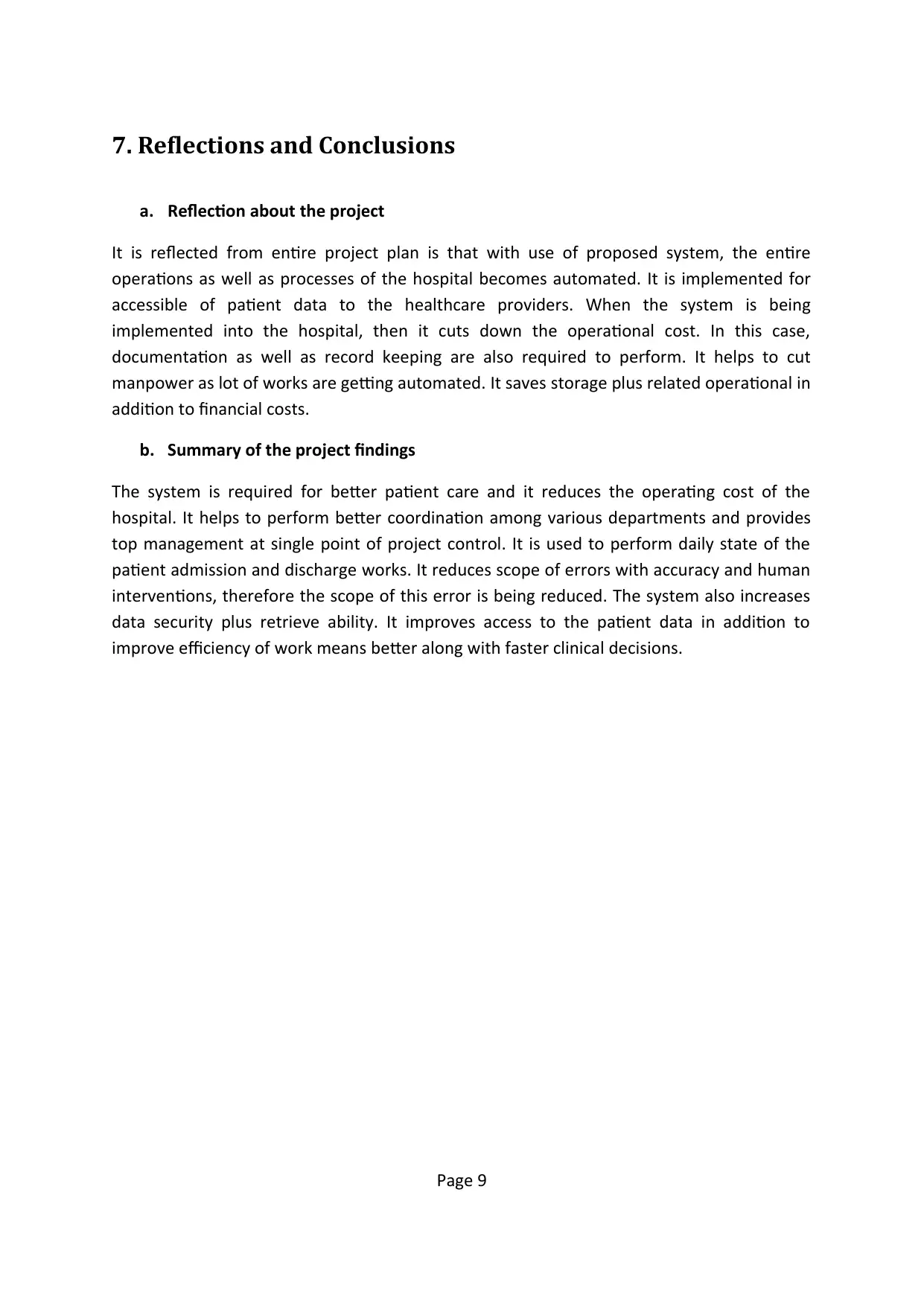
7. Reflections and Conclusions
a. Reflection about the project
It is reflected from entire project plan is that with use of proposed system, the entire
operations as well as processes of the hospital becomes automated. It is implemented for
accessible of patient data to the healthcare providers. When the system is being
implemented into the hospital, then it cuts down the operational cost. In this case,
documentation as well as record keeping are also required to perform. It helps to cut
manpower as lot of works are getting automated. It saves storage plus related operational in
addition to financial costs.
b. Summary of the project findings
The system is required for better patient care and it reduces the operating cost of the
hospital. It helps to perform better coordination among various departments and provides
top management at single point of project control. It is used to perform daily state of the
patient admission and discharge works. It reduces scope of errors with accuracy and human
interventions, therefore the scope of this error is being reduced. The system also increases
data security plus retrieve ability. It improves access to the patient data in addition to
improve efficiency of work means better along with faster clinical decisions.
Page 9
a. Reflection about the project
It is reflected from entire project plan is that with use of proposed system, the entire
operations as well as processes of the hospital becomes automated. It is implemented for
accessible of patient data to the healthcare providers. When the system is being
implemented into the hospital, then it cuts down the operational cost. In this case,
documentation as well as record keeping are also required to perform. It helps to cut
manpower as lot of works are getting automated. It saves storage plus related operational in
addition to financial costs.
b. Summary of the project findings
The system is required for better patient care and it reduces the operating cost of the
hospital. It helps to perform better coordination among various departments and provides
top management at single point of project control. It is used to perform daily state of the
patient admission and discharge works. It reduces scope of errors with accuracy and human
interventions, therefore the scope of this error is being reduced. The system also increases
data security plus retrieve ability. It improves access to the patient data in addition to
improve efficiency of work means better along with faster clinical decisions.
Page 9
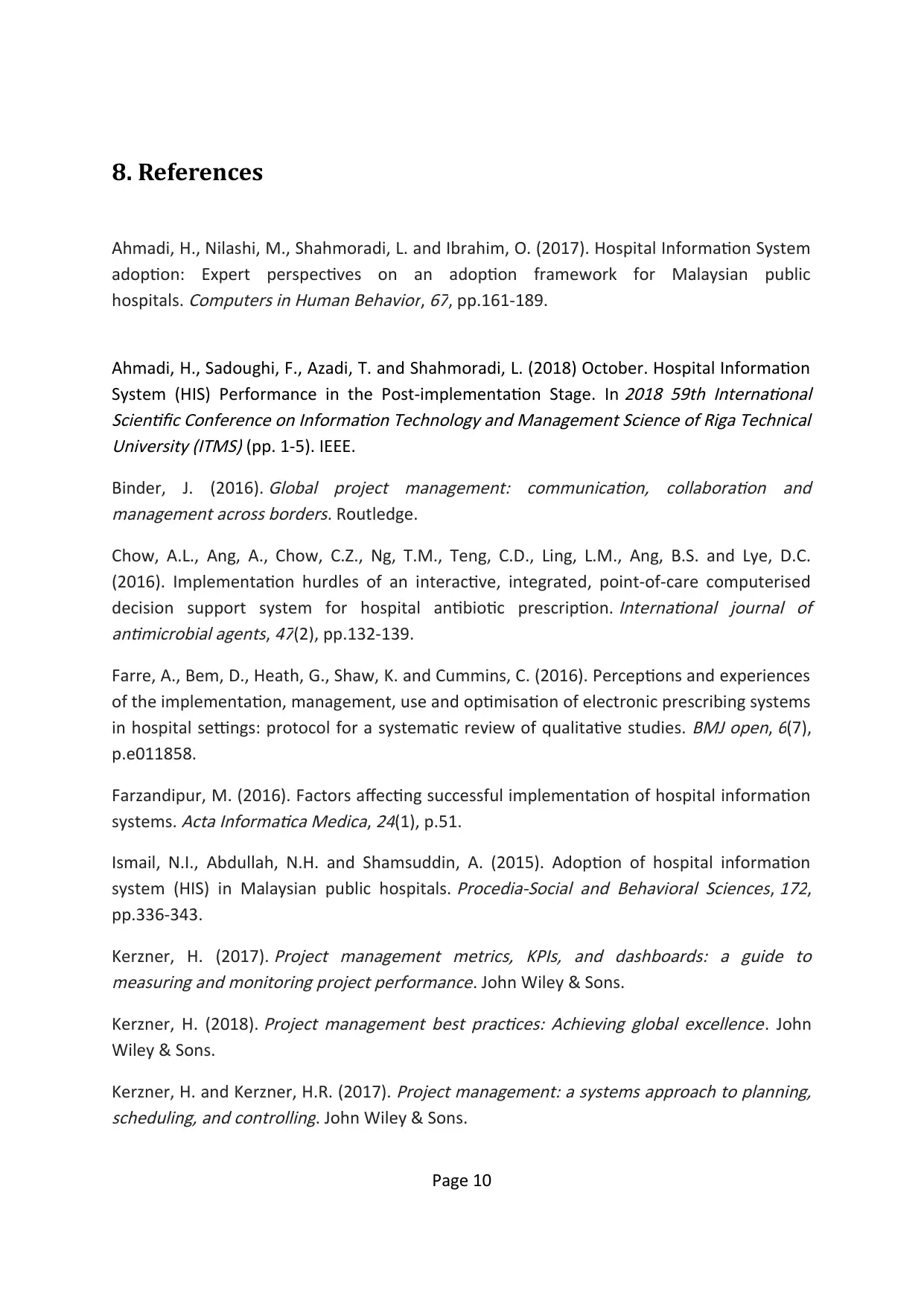
8. References
Ahmadi, H., Nilashi, M., Shahmoradi, L. and Ibrahim, O. (2017). Hospital Information System
adoption: Expert perspectives on an adoption framework for Malaysian public
hospitals.
Computers in Human Behavior,
67, pp.161-189.
Ahmadi, H., Sadoughi, F., Azadi, T. and Shahmoradi, L. (2018) October. Hospital Information
System (HIS) Performance in the Post-implementation Stage. In
2018 59th International
Scientific Conference on Information Technology and Management Science of Riga Technical
University (ITMS) (pp. 1-5). IEEE.
Binder, J. (2016).
Global project management: communication, collaboration and
management across borders. Routledge.
Chow, A.L., Ang, A., Chow, C.Z., Ng, T.M., Teng, C.D., Ling, L.M., Ang, B.S. and Lye, D.C.
(2016). Implementation hurdles of an interactive, integrated, point-of-care computerised
decision support system for hospital antibiotic prescription.
International journal of
antimicrobial agents,
47(2), pp.132-139.
Farre, A., Bem, D., Heath, G., Shaw, K. and Cummins, C. (2016). Perceptions and experiences
of the implementation, management, use and optimisation of electronic prescribing systems
in hospital settings: protocol for a systematic review of qualitative studies.
BMJ open,
6(7),
p.e011858.
Farzandipur, M. (2016). Factors affecting successful implementation of hospital information
systems.
Acta Informatica Medica,
24(1), p.51.
Ismail, N.I., Abdullah, N.H. and Shamsuddin, A. (2015). Adoption of hospital information
system (HIS) in Malaysian public hospitals.
Procedia-Social and Behavioral Sciences,
172,
pp.336-343.
Kerzner, H. (2017).
Project management metrics, KPIs, and dashboards: a guide to
measuring and monitoring project performance. John Wiley & Sons.
Kerzner, H. (2018).
Project management best practices: Achieving global excellence. John
Wiley & Sons.
Kerzner, H. and Kerzner, H.R. (2017).
Project management: a systems approach to planning,
scheduling, and controlling. John Wiley & Sons.
Page 10
Ahmadi, H., Nilashi, M., Shahmoradi, L. and Ibrahim, O. (2017). Hospital Information System
adoption: Expert perspectives on an adoption framework for Malaysian public
hospitals.
Computers in Human Behavior,
67, pp.161-189.
Ahmadi, H., Sadoughi, F., Azadi, T. and Shahmoradi, L. (2018) October. Hospital Information
System (HIS) Performance in the Post-implementation Stage. In
2018 59th International
Scientific Conference on Information Technology and Management Science of Riga Technical
University (ITMS) (pp. 1-5). IEEE.
Binder, J. (2016).
Global project management: communication, collaboration and
management across borders. Routledge.
Chow, A.L., Ang, A., Chow, C.Z., Ng, T.M., Teng, C.D., Ling, L.M., Ang, B.S. and Lye, D.C.
(2016). Implementation hurdles of an interactive, integrated, point-of-care computerised
decision support system for hospital antibiotic prescription.
International journal of
antimicrobial agents,
47(2), pp.132-139.
Farre, A., Bem, D., Heath, G., Shaw, K. and Cummins, C. (2016). Perceptions and experiences
of the implementation, management, use and optimisation of electronic prescribing systems
in hospital settings: protocol for a systematic review of qualitative studies.
BMJ open,
6(7),
p.e011858.
Farzandipur, M. (2016). Factors affecting successful implementation of hospital information
systems.
Acta Informatica Medica,
24(1), p.51.
Ismail, N.I., Abdullah, N.H. and Shamsuddin, A. (2015). Adoption of hospital information
system (HIS) in Malaysian public hospitals.
Procedia-Social and Behavioral Sciences,
172,
pp.336-343.
Kerzner, H. (2017).
Project management metrics, KPIs, and dashboards: a guide to
measuring and monitoring project performance. John Wiley & Sons.
Kerzner, H. (2018).
Project management best practices: Achieving global excellence. John
Wiley & Sons.
Kerzner, H. and Kerzner, H.R. (2017).
Project management: a systems approach to planning,
scheduling, and controlling. John Wiley & Sons.
Page 10
⊘ This is a preview!⊘
Do you want full access?
Subscribe today to unlock all pages.

Trusted by 1+ million students worldwide
1 out of 13
Related Documents
Your All-in-One AI-Powered Toolkit for Academic Success.
+13062052269
info@desklib.com
Available 24*7 on WhatsApp / Email
![[object Object]](/_next/static/media/star-bottom.7253800d.svg)
Unlock your academic potential
Copyright © 2020–2025 A2Z Services. All Rights Reserved. Developed and managed by ZUCOL.




